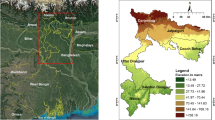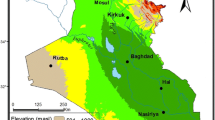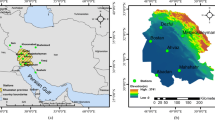Abstract
The present paper analyzes long term (1960–2021) of the minimum, maximum, and average temperatures in Central Anatolia Region, corresponding middle part of Turkey, aiming to reveal how strongly the temperatures increase, which is a precondition for sustainable development in this region. For this purpose, temporal trends, variability, and anomalies in temperatures of 27 meteorological stations were detected using Mann–Kendall test (M-K), coefficient of variations, and Gaussian filter, respectively. Results show a statistically significant increasing trend in annual average temperatures at approximately 92% of all stations. This shows that the increasing trend in spring and summer temperatures plays an important role in amplifying the warming trend of annual temperatures. The coefficients of variation in annual average, maximum, and seasonal temperatures increase from west to east. Significant strong increasing trend (at 0.001 level) in winter temperatures was detected only at Seydişehir. While positive anomalies have been observed in the northwestern part of the region since 2007, they have been observed in other parts since 1995–1996. Since the strong increase in summer temperatures in Aksaray, Cihanbeyli, and Seydişehir is also observed in autumn, warm conditions continue until the end of autumn in these settlements. For this reason, four seasons do not prominently occur for all three settlements. Generally, annual maximum and minimum temperatures illustrate statistically significant increasing trends for all stations and 74% of all stations, respectively. According to the M-K test results, climate of the region has warmed on average by 1.44 °C in last 31 years.











Similar content being viewed by others
Data availability
The data sets analyzed during the current study are available from the corresponding author on reasonable request.
Code availability
Not applicable.
References
Abbasnia M, Toros H (2020) Trend analysis of weather extremes across the coastal and non-coastal areas (case study: Turkey). J Earth Sys Sci. https://doi.org/10.1007/s12040-020-1359-3
Akın B (2019) Drought analysıs in Tuz Lake Basin. Ulusal Çevre Bilimleri Araştırma Dergisi 2:44–56 (in Turkish)
Avcı M (2014) The last shelters for the remaining forests of the Central Anatolia Region the vegetation on Karacadağ and Karadağ volcanoes. Çantay, Istanbul (in Turkish)
Aykır D (2017) Urbanization effect on trends of extreme temperature indices in Turkey. Turkish Geogr Rev 69:47–57
Bayer-Altın T (2008) The effects of wrong land-use on distribution of vegetation at Mt. Keçiboyduran and Mt Melendiz. Turkish Geogr Rev 51:13–32 (in Turkish)
Bayer-Altın T (2022) Relationships between productive oak forests and pumice in Southern central Anatolia, Turkey. In: Sönmez S (ed) Current debates in social, humanities and administrative sciences, 1st edn. Duvar Publishing, Izmir, pp 530–542
Bayer-Altın T, Barak B (2017) Trends and changes in tropical and summer days at the Adana sub-region of the Mediterranean region, Southern Turkey. Atmos Res 196:182–199
Bayer-Altın T, Barak B, Altın BN (2012) Change in precipitation and temperature amounts over three decades in Central Anatolia, Türkiye. Atmos Clim Sci 2:107–125
Bhutiyani MR, Kale VS, Pawar NJ (2007) Long-term trends in maximum, minimum and mean annual air temperatures across the Northwestern Himalaya during the twentieth century. Clim Change 85:159–177
Bosneagu R, Lupu CE, Torica E et al (2022) Long-term analysis of air temperatures variability and trends on the Romanian black sea coast. Acta Geophys 70:2179–2197
Camuffo D, Bertolin C, Barriendos M et al (2010) 500-year temperature reconstruction in the Mediterranean basin by means of documentary data and instrumental observations. Clim Change 101:169–199
Çapar G (2019) Water resources management and climate change. In: Climate change education modules series 8. http://suyonetimi.ankara.edu.tr/wpcontent/uploads/sites/88/2019/10/%C4%B0klim%C4%B0N-Projesi-E%C4%9Fitim-Serisi-Mod%C3%BCl-8.pdf. Accessed 5 July 2022.
Çatal A, Dengiz O (2015) From being Akşehir lake to being Akşehir desert: the process and the influential factors. Toprak Su Dergisi 4:18–26 (in Turkish)
Çelebioğlu T, Tayanç M, Oruç HN (2021) Detremination of temperature variabilities and trends in Turkey. Bursa Uludağ Univ J Fac Eng 26:1003–1020
Charney JG (1975) Dynamics of deserts and drought in the Sahel. Q J R Meteorol Soc 101:193–202
Cherwin K, Knapp A (2012) Unexpected patterns of sensitivity to drought in three semi-arid grasslands. Oecologia 169:845–852
Christensen JH, Kanikicharla KK, Aldrian E et al (2013) Climate phenomena and their relevance for future regional climate change. In: Stocker TF, Qin D, Plattner GK et al (eds) Climate change, the physical science basis. Contribution of working Group I to the fifth assessment report of the intergovernmental panel on climate change. Cambridge University Press, Cambridge, pp 1217–1285
Çiçek İ (2005) Variation in urban and rural temperatures differences in Ankara (1970–2002). Fırat Univ J Soc Sci 15:1–16 (in Turkish)
Çiftçi E, Günek H, Nazik L (2021) Natural environment characteristics in Seyfe lake basin (Kirşehir). Black Sea J Public Soc Sci 2:42–53 (in Turkish)
CSB (2020) Regional climate change action plans. https://webdosya.csb.gov.tr/db/ordu/menu/bidep_rapor_v14_maket-1_20210315075810.pdf. Accessed 1 Aug 2022.
De Laat ATJ, Maurellis AN (2006) Evidence for influence of anthropogenic surface processes on lower tropospheric and surface temperature trends. Int J Climatol 26:897–913
Demircan M, Gürkan H, Eskioğlu O et al (2017) Climate change projections for Turkey: three models and two scenarios. Turkish J Water Sci Manag 1:22–43
Easterling DR, Horton B, Jones PD (1997) Maximum and minimum temperature trends for the globe. Science 277:364–367
EEA (2022) Global and European temperatures. In: European environment agency publishing. https://www.eea.europa.eu/ims/global-and-european-temperatures. Accessed 26 Nov 2022.
Erlat E, Türkeş M (2016) Dates of frost onset, frost end and the frost-free season in Turkey: trends, variability and links to the North Atlantic and Arctic oscillation indices, 1950–2013. Clim Res 69:155–176
Erlat E, Yavaşlı DD (2009) Assessment of variability and trends in temperature extremes over Aegean region of Turkey. Ankara Univ J Environ Sci 1(3):25–37 (in Turkish)
Feng R, Yu RD, Zheng HW et al (2017) Spatial and temporal variations in extreme temperature in central Asia. Int J Climatol 38:388–400
Giannini A (2009) Climate change in the Sahel: connecting past and future. IOP Conf Ser Earth Environ Sci 6:342022
Hu Q, Willson GD (2000) Effects of temperature anomalies on the palmer drought severity index in the central United States. Int J Climatol 20:1899–1911
Huang J, Zhang W, Zuo J et al (2008) An overview of the semi-arid climate and environment research observatory over the Loess Plateau. Adv Atmos Sci 25:906–921
Huang J, Guan X, Ji F (2012) Enhanced cold-season warming in semi-arid regions. Atmos Chem Phys Discuss 12:4627–4653
Huxman TE, Smith MD, Fay PA et al (2004) Convergence across biomes to a common rain-use effciency. Nature 429:651–654
İçel G, Ataol M (2014) The trends in annual average temperatures and precipitations in Turkey and relationship with NAO (1975–2009). Coğrafya Dergisi 28:55–68 (in Turkish)
IPCC (2001) Climate change 2001: the scientific basis. contribution of working group I to the third assessment report of the intergovernmental panel on climate change. In: Houghton JT, Ding Y, Griggs DJ et al (eds) Climate change 2001: the scientific basis. Cambridge University Press, Cambridge, New York, p 881
IPCC (2018) Global warming of 1.5°C. An IPCC special report on the impacts of global warming of 1.5 °C above pre-industrial levels and related global greenhouse gas emission pathways, in the context of strengthening the global response to the threat of climate change, sustainable development, and efforts to eradicate poverty. In: Masson-Delmotte V, Zhai P, H-O Pörtner et al (eds). https://www.ipcc.ch/sr15/download/. Accessed 20 Oct 2022.
IPCC (2019) Climate change and land: An IPCC special report on climate change, desertification, land degradation, sustainable land. The Intergovernmental Panel on Climate Change. In: Skea PR, Calvo BE, Masson-Delmotte V et al (eds). https://www.ipcc.ch/site/assets/uploads/sites/2/2019/06/SR15_Full_Report_High_Res.pdf. Accessed 20 Oct 2022
IPCC (2021) Climate Change 2021: The physical science basis, summary for policymaker. In: Masson-Delmotte et al (eds) Contribution of working group I to the sixth assessment report of the intergovermental panel on climate change IPCC. Geneva, p 40
İrcan MR, Duman N (2022) Trend analysis of maximum and minimum temperatures in the Van Lake Basin. Turkish Geogr Rev 80:39–52
Johns T, Gregory J, Ingram W et al (2003) Anthropogenic climate change for 1860 to 2100 simulated with the HadCM3 model under updated emissions scenarios. Clim Dyn 20:583–612
Kadıoğlu M, Ünal Y, İlhan, A, Yürük C (2017) Climate change and sustainability in agriculture. In: Federation of Turkish food and beverage industry associations. http://www.tgdf.org.tr/wpcontent/uploads/2017/10/iklim-degisikligi-aporelma.compressed.pdf. Accessed 5 Oct 2022.
Kendall MG (1975) Rank correlation methods. Charles Griffin, London
Kıymaz S, Güneş V, Asar M (2011) Determination of drought periods for Seyfe Lake by standardized precipitation index. J Gaziosmanpaşa Univ Fac Agric 28:91–102 (in Turkish)
Kızılelma Y, Çelik MA, Karabulut M (2015) Trend analyses of temperature and precipitations in central Anatolia. Türk Coğrafya Dergisi 64:1–10 (in Turkish)
Knapp AK, Smith MD (2001) Variation among biomes in temporal dynamics of aboveground primary production. Science 291:481–484
Kruger AC, Shongwe S (2004) Temperature trends in South Africa, 1960–2003. Int J Climatol 24:1929–1945
Kukla G, Gavin J (1986) Urban warming. J Clim Appl Meteorol 25:1265–1270
Kürschner H, Parolly G (2012) The central Anatolia steppe. In: Werger M, van Staalduinen M (eds) Eurasian steppes. Ecological problems and livelihoods in a changing world. Plant and vegetation 6, 1st edn. Springer, Dordrecht, pp 149–171
Kuzu SL, Çetinkaya AL (2019) Climatological evaluation in a Central Anatolian city and indirect effects of climatological variation on air quality. Air Qual Atmos Health 12:847–854
Landsberg HE (1981) The urban climate. International Geophysics series 28. Academic Press, New York
Lian X, Piao S, Chen A et al (2021) Multifaceted characteristics of dryland aridity changes in a warming world. Nat Rev Earth Environ 2:232–250
Liu H, Wang B, Fu C (2008) Relationships between surface albedo, soil thermal parameters and soil moisture in the semi-arid area of Tongyu, northeastern China. Adv Atmos Sci 25:757–764
Liu Y, Geng X, Hao Z (2020) Changes in climate extremes in Central Asia under 1.5 and 2 °C global warming and their impacts on agricultural productions. Atmosphere 11:1076. https://doi.org/10.3390/atmos11101076
Mann HB (1945) Non-parametric tests against trend. Econometrica 13:245–259
McKitrick R, Michaels PJ (2004) Are temperature trends affected by economic activity? Reply to Benestad (2004). Climate Res 2:175–176
Nastos PT, Matzarakis A (2008) Variability of tropical days over Greece within the second half of the twentieth century. Theoret Appl Climatol 93:75–89
Özturk T, Altınsoy H, Türkeş M, Kurnaz ML (2012) Simulation of temperature and precipitation climatology for central Asia CORDEX domain by using RegCM 4.0. Climate Res 52:63–76
Pisano A, Marullo S, Artale V et al (2020) New evidence of Mediterranean climate change and variability from sea surface temperature observations. Remote Sens 12:132. https://doi.org/10.3390/rs12010132
Rosenzweig C, Karoly D, Vicarelli M et al (2008) Attributing physical and biological impacts to anthropogenic climate change. Nature 453(7193):353–357
Roternberg E, Yakir D (2010) Contribution of semi-arid forests to the climate system. Science 327:451–454
Sarr B (2012) Present and future climate change in the semi-arid region of West Africa: a crucial input for practical adaptation in agriculture. Atmos Sci Lett. https://doi.org/10.1002/asl.368
Scheff J, Frierson DMW (2015) Terrestrial aridity and its response to greenhouse warming across CMIP5 climate models. J Clim 28:5583–5600
Scholes RJ (2020) The future of semi-arid regions: a weak fabric unravels. Climate 8:43. https://doi.org/10.3390/cli8030043
Şen B, Topçu S, Türkeş M, Şen B, Warner JF (2012) Projecting climate change, drought conditions and crop productivity in Turkey. Clim Res 52:175–191
Skea PR, Calvo J, Masson-Delmotte, BE et al (2019) Climate change and land: An IPCC special report on climate change, desertification, land degradation, sustainable land. In: The intergovernmental panel on climate change (IPCC). https://www.ipcc.ch/site/assets/uploads/2019/11/SRCCL-Full-Report-Compiled-191128.pdf. Accessed 5 Sept 2022.
Sneyers R (1990) On the statistical analysis of series of observations. World meteorological organization technical note 43, Geneva
Sutton WR, Srivastava JP, Neumann JE et al (2013) Reducing the vulnerability of Uzbekistan’s agricultural systems to climate change. In: Impact assessment and adaptation options. The World Bank, Washington DC
Tayanç M, Im U, Doğruel M, Karaca M (2009) Climate change in Turkey for the last half century. Clim Change 94:483–502
TMAF (2016) Republic of Turkey ministry of agriculture and forestry. In: Climate change impact on water resources project, executive summary. https://www.tarimorman.gov.tr/SYGM/Belgeler/iklim%20de%C4%9Fi%C5%9Fikli%C4%9Finin%20su%20kaynaklar%C4%B1na%20etkisi/Iklim_NihaiRapor.pdf. Accessed 9 Aug 2022
Trenberth KE (1999) Conceptual framework for changes of extremes of the hydrological cycle with climate change. Clim Change 42:327–339
Türkeş M (1995) Analysis of changes and trends in annual average air temperatures in Turkey in terms of climate change. Environment and Engineer 9:9–15 (in Turkish)
Türkeş M (1999) Vulnerability of Turkey to desertification with respect to precipitation and aridity conditions. Turk J Eng Environ Sci 23:363–380
Türkeş M (2002) Climate Change and Sustainable Development National Assessment Report. Türkiye Teknoloji Geliştirme Vakfı (TTGV), Istanbul (in Turkish)
Türkeş M (2005) Climate of southern part of the Middle Kızılırmak sub-region (Cappadocia District) and its vulnerability to desertification. Aegean Geogr J 14:73–97 (in Turkish)
Türkeş M (2010) Climatology and meteorology. Kriter Publisher, Istanbul (in Turkish)
Türkeş M (2012) Observed and projected climate change, drought and desertification in Turkey. Ankara Univ J Environ Sci 4:1–32 (in Turkish)
Türkeş M, Erlat E (2003) Precipitation changes and variability in Turkey linked to the North Atlantic oscillation during the period 1930–2000. Int J Climatol 23:1771–1796
Türkeş M, Erlat E (2009) Winter mean temperature variability in Turkey associated with the North Atlantic oscillation. Meteorol Atmos Phys 105:211–225
Türkeş M, Sümer UM, Demir İ (2002) Re-evaluation of trends and changes in mean, maximum and minimum temperatures of Turkey for the period 1929–1999. Int J Climatol 22:947–977
Türkeş M, Akgündüz AS, Demirörs Z (2009) Drought periods and severity over the Konya Sub-region of the Central Anatolia Region according to the Palmer Drought Index. Coğrafi Bilimler Dergisi 7:129–144 (in Turkish)
Türkeş M, Öztaş T, Tercan E et al (2020) Desertification vulnerability and risk assessment for Turkey via an analytical hierarchy process model. Land Degrad Dev 31:205–214
Türkeş M (2008) Climate change and global warming phenomenon: scientific evaluation. In: Global warming and the Kyoto protocol: scientific, economic and political analysis of climate change. Bağlam Publications, Istanbul (in Turkish)
Turp MT, Öztürk T, Türkeş M, Kurnaz ML (2014) Investigation of projected changes for near future air temperature and precipitation climatology of Turkey and surrounding regions by using the regional climate model RegCM4.3.5. Aegean Geogr J 23:1–24
TVKGM (2011) General directorate of conservation of natural assets. In: Tuz Gölü special environmental protection zone management plan 2014–2018. https://webdosya.csb.gov.tr/db/tabiat/editordosya/tuz%20golu-4(2).pdf. Accessed 10 Aug 2022.
UKMO (1995) Modeling Climate Change 1860-2050. In: The Hadley centre for climate prediction and research. United Kingdom Meteorological Office (UKMO) Publish, London
Wallace JM, Zhang Y, Renwick JA (1995) Dynamic contribution to hemispheric mean temperature trends. Science 270:780–783
Wallace JM, Zhang Y, Bajuk L (1996) Interpretation of interdecadal trends in Northern Hemisphere surface air temperature. J Clim 9:249–259
WMO (1966) Climatic change, WMO technical note, 79. World Meteorological Organization, Geneva, p 79
WWF (2010) Wildlife conservation foundation, Turkey's future project final report. WWF Publish, Ankara
Xue Y, Shukla J (1993) The influence of land surface properties on Sahel climate. Part 1: desertification. J Clim 6:2232–2245
Yurteri C (2020) Hydrogeological and hydrochemical evaluation of water resources in Seyfe lake (Mucur-Kırşehir) wetland basin. Dokuz Eylul Univ Facu Eng J Sci Eng 22:581–597
Zhang Q, Wei G, Huang R (2001) The bulk transfer coefficients of the atmospheric momentum and sensible heat over desert and Gobi in arid climate region of Northwest China. Sci China Ser D 31:783–792
Zheng X, Eltahir EAB (1998) The role of vegetation in the dynamics of West African monsoons. J Clim 11:2078–2096
Zhou J, Huang J, Zhao X et al (2020) Changes of extreme temperature and its influencing factors in Shiyang river basin Northwest China. Atmosphere 11:1171. https://doi.org/10.3390/atmos11111171
Funding
The authors received no financial support for the research, authorship, and/or publication of this article.
Author information
Authors and Affiliations
Corresponding author
Ethics declarations
Conflict of interest
The author declares no competing interests.
Consent to participate
Not applicable.
Consent for publication
Not applicable.
Ethical approval
Not applicable.
Additional information
Edited by Prof. Ewa Bednorz (ASSOCIATE EDITOR) / Prof. Theodore Karacostas (CO-EDITOR-IN-CHIEF).
Rights and permissions
Springer Nature or its licensor (e.g. a society or other partner) holds exclusive rights to this article under a publishing agreement with the author(s) or other rightsholder(s); author self-archiving of the accepted manuscript version of this article is solely governed by the terms of such publishing agreement and applicable law.
About this article
Cite this article
Bayer-Altın, T. Long-term trends and variability in air temperatures of central Anatolia region, Turkey, for the period 1960–2021. Acta Geophys. 71, 2031–2047 (2023). https://doi.org/10.1007/s11600-023-01077-6
Received:
Accepted:
Published:
Issue Date:
DOI: https://doi.org/10.1007/s11600-023-01077-6




